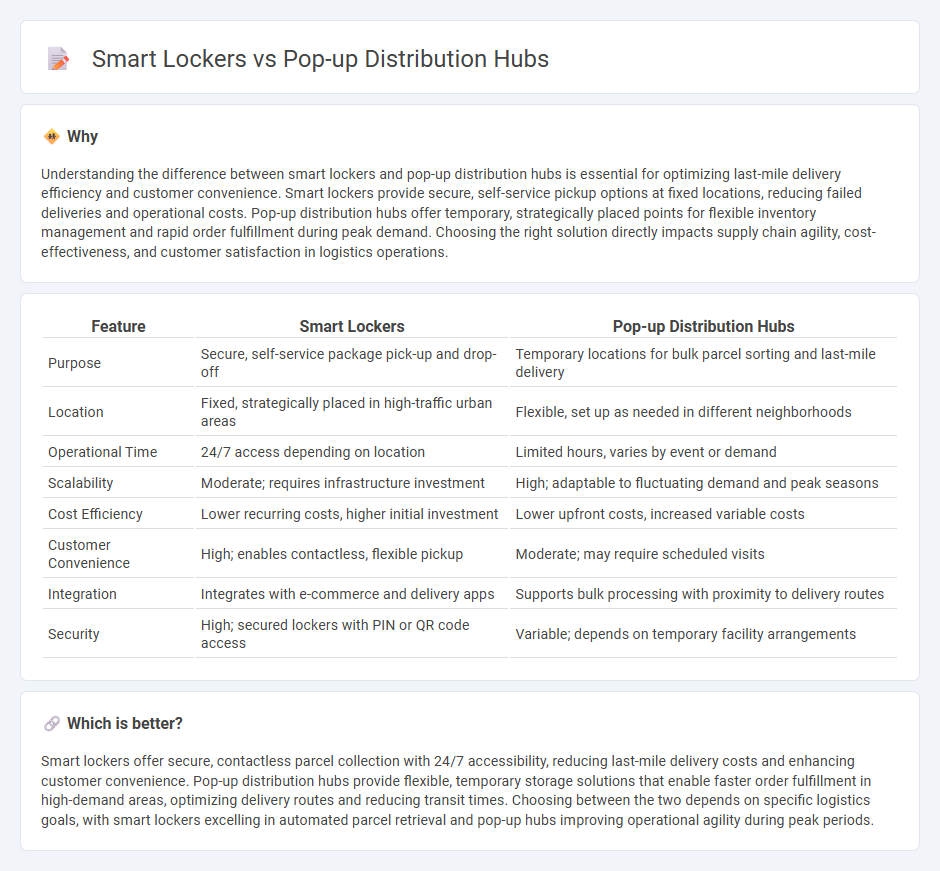
Smart lockers offer secure, automated parcel collection points that enhance last-mile delivery efficiency and reduce missed deliveries. Pop-up distribution hubs provide flexible, temporary locations to expedite shipment sorting and distribution during peak demand periods. Explore the advantages and use cases of smart lockers and pop-up hubs to optimize your logistics strategy.
Why it is important
Understanding the difference between smart lockers and pop-up distribution hubs is essential for optimizing last-mile delivery efficiency and customer convenience. Smart lockers provide secure, self-service pickup options at fixed locations, reducing failed deliveries and operational costs. Pop-up distribution hubs offer temporary, strategically placed points for flexible inventory management and rapid order fulfillment during peak demand. Choosing the right solution directly impacts supply chain agility, cost-effectiveness, and customer satisfaction in logistics operations.
Comparison Table
| Feature | Smart Lockers | Pop-up Distribution Hubs |
|---|---|---|
| Purpose | Secure, self-service package pick-up and drop-off | Temporary locations for bulk parcel sorting and last-mile delivery |
| Location | Fixed, strategically placed in high-traffic urban areas | Flexible, set up as needed in different neighborhoods |
| Operational Time | 24/7 access depending on location | Limited hours, varies by event or demand |
| Scalability | Moderate; requires infrastructure investment | High; adaptable to fluctuating demand and peak seasons |
| Cost Efficiency | Lower recurring costs, higher initial investment | Lower upfront costs, increased variable costs |
| Customer Convenience | High; enables contactless, flexible pickup | Moderate; may require scheduled visits |
| Integration | Integrates with e-commerce and delivery apps | Supports bulk processing with proximity to delivery routes |
| Security | High; secured lockers with PIN or QR code access | Variable; depends on temporary facility arrangements |
Which is better?
Smart lockers offer secure, contactless parcel collection with 24/7 accessibility, reducing last-mile delivery costs and enhancing customer convenience. Pop-up distribution hubs provide flexible, temporary storage solutions that enable faster order fulfillment in high-demand areas, optimizing delivery routes and reducing transit times. Choosing between the two depends on specific logistics goals, with smart lockers excelling in automated parcel retrieval and pop-up hubs improving operational agility during peak periods.
Connection
Smart lockers and pop-up distribution hubs enhance last-mile logistics by enabling flexible, secure parcel storage and retrieval. These technologies decrease delivery times and reduce operational costs by optimizing delivery routes and minimizing failed delivery attempts. Integration of smart lockers within pop-up hubs supports scalable urban distribution networks, promoting efficient e-commerce fulfillment.
Key Terms
Flexibility
Pop-up distribution hubs offer unmatched flexibility through temporary, scalable locations that adapt to fluctuating demand and seasonal surges, optimizing last-mile delivery. Smart lockers provide fixed, secure, and contactless pickup points with 24/7 accessibility, enhancing convenience but limiting location flexibility compared to pop-up hubs. Explore how combining these solutions can elevate your logistics strategy.
Last-mile delivery
Pop-up distribution hubs reduce last-mile delivery times by strategically positioning inventory closer to demand hotspots, enabling faster order fulfillment with fewer transportation miles. In contrast, smart lockers offer secure, self-service parcel pick-up points that enhance delivery flexibility and reduce failed delivery attempts through 24/7 accessibility. Explore the comparative benefits of pop-up hubs and smart lockers to optimize your last-mile logistics strategy.
Contactless access
Pop-up distribution hubs offer temporary, scalable locations for fast parcel pickup, while smart lockers provide secure, permanent access points with advanced contactless technology. Both solutions prioritize reducing human interaction through QR codes, RFID, or mobile app integrations, enhancing safety and convenience in last-mile delivery. Explore the latest innovations in contactless access to optimize your e-commerce fulfillment strategy.
Source and External Links
Pop-Up Distribution Centers Overcome Last-Mile Delivery Obstacles - Pop-up distribution centers, also known as micro-fulfillment centers, can be rapidly established in high-demand areas to shorten delivery distances and times, providing flexibility and cost-effectiveness especially during disruptions like COVID-19.
Creating a "Pop-Up Distribution Center" In Your Warehouse - Pop-up distribution centers are temporary, smaller operational areas inside warehouses designed to streamline shipping and fulfillment, reducing handling time and costs by processing orders directly without transferring to other facilities.
Pop-Up Warehousing: Definition, Risks, and Benefits - Pop-up warehousing involves temporarily converting underused spaces into micro-fulfillment hubs to manage seasonal demand spikes or market fluctuations, offering strategic location advantages and scalable, on-demand storage without long-term leasing commitments.
 dowidth.com
dowidth.com